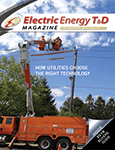Over the course of its approximately 100-year history, the effort now known as the National Electrical Safety Code (NESC) has changed its form and procedures to keep up with industry developments. At the beginning in 1915, the NESC was created under the National Bureau of Standards. In 1972 the Institute of Electrical and Electronics Engineers (IEEE) became secretariat of the NESC and still serves that roll today.
The code itself has been written in discreet parts that are presented, as it is today, in a unified document. Its content has always contained some design criteria alongside its focus on safety but is not comprehensive enough to serve as a design guide. The NESC’s revision cycle moved to every three years in the late 1970s and, in 1997, it moved to five years. Some of the key changes proposed for the 2017 NESC edition are focused on making the code more readable and intuitive, as well as other additions and amendments that impact particular applications. Here’s a look at some of the more significant changes in the 2017 edition.
A good example that underpins efforts to make the code more user friendly is the reformatting of Rule 241C ‘At crossings’, which has been transformed from a single, long sentence paragraph to a bulleted format that is easier to comprehend. While the requirements are the same, the more readable format demonstrates a general effort to improve the NESC based on users’ inputs. Table 242-1 “Grades of Construction…at crossing” was also reformatted for the 2017 edition. The requirements remain the same, but the layout was changed to a more logical sequence of increasing voltages for the columns and rows.
There is one change to note in the content of Table 242- 1 that is beyond formatting but still does not change the requirement. The last column in the table is for open supply conductors exceeding 22kV crossing other wires or infrastructure. In the 2012 edition, the grade of construction required in the table was Grade C with a referral to footnote 3. The footnote stated that if the supply circuits will not be promptly de-energized in the event of contact with a lower conductor or cable, then Grade B construction was required.
The 2017 edition has Grade B required in the table and the footnote now states that Grade C can be used if the circuits will be promptly de-energized. The requirements are the same but it is better code to show the higher requirement in the table.
Also new in the 2017 edition is a revised Rule 261H1 ‘Tensions.’ This change adds a requirement to address the potential for Aeolian vibration of a conductor and to consider methods of mitigation. Aeolian vibration is low amplitude, high frequency vibration that is most common on transmission lines, and causes damage to conductor strands at suspension clamps and other attachment points. There are multiple ways specified in the rule to mitigate this potential, but if limiting tension is the only option, limits are specified as a percent of ultimate conductor capacities.
The 2017 NESC edition now reflects the work that insulator manufacturers have pursued for changing insulator ratings. The effort was a combined effort within ANSI C29 and IEEE along with members of NESC Subcommittee 5 over the last ten years to change the rating method for Line Post and Transmission Suspension insulators. The former and new ratings are:
Line Post Insulators
- Former rating: an average value with no single insulator less than 85% of the average
- New rating: a minimum value for all insulators
Transmission Suspension Insulators
- Former rating: 1.2 Standard deviations (approx. 80% of insulators exceed the rated value)
- New rating: 3 Standard deviations (99.7% of insulators exceed the rating)
The 2017 NESC adopted a comprehensive change proposal for section 27 that adopted these and other changes related to insulators. First to note is a new exception added to Rule 274. “Factory tests” which reads:
“EXCEPTION: Where guy insulators are manufactured per designs for which validation tests have been performed as specified in Rule 279A1b “Guy span and insulators- Electrical strength” and a valid quality assurance program is followed, this rule does not require that dry and wet flashover tests be performed on each guy insulator unit.”
Most of the other 2017 significant changes appear in Table 277-1 ‘Allowed percentages of strength ratings.’ First to note is there are now separate allowable percentages of strength for Rule 250B versus Rule 250C and D. Previously, only Rule 250B was addressed by this table, with the inclusion of a statement that proper allowance needed to be made for Rules 250C and D.
Other industry changes adopted into the table include adjusting the allowable percentages of strength values where changes in the ratings have taken affect and creating Distribution and Transmission classes for suspension insulators.
Additionally, an Exception was added to Rule 277 allowing the use of strength rating percentages different from the values in Table 277-1 if they can be supported by a qualified engineering study, operating experience or manufacturer’s recommendations.
These are just a few highlights of the proposed changes to the 2017 NESC edition. An NESC Workshop is scheduled for October 18-19, 2016 in San Antonio, TX. A review of the changes in all sections of the code will be presented on the first morning. Additional segments will discuss the adoption of solar and wind power into the NESC along with new technologies and a vision for the code of the future
The new code itself will be published on August 1st, 2016, along with training and learning tools, including a new handbook and a MOOC scheduled for August 2016.
Learn more about the NESC and related products at standards.ieee.org/nesc/.
About the Author
 Nelson Bingel, Osmose Utilities Services, is a member of the NESC Main and Executive Subcommittees and chair of NESC Subcommittee 5.
Nelson Bingel, Osmose Utilities Services, is a member of the NESC Main and Executive Subcommittees and chair of NESC Subcommittee 5.







